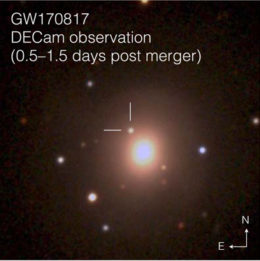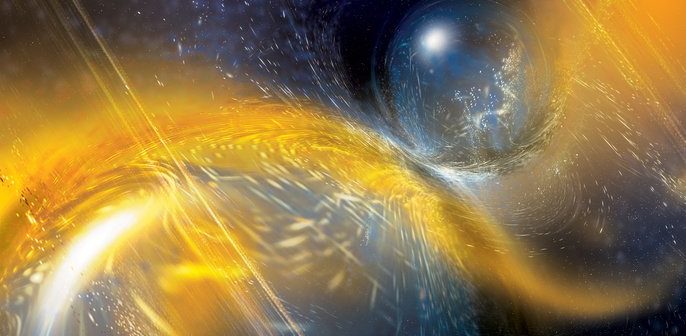Gravitational-wave events have allowed us to measure distances in space in a way that’s independent of previous techniques. By extension, we can also make independent measurements of the universe’s rate of expansion, expressed as the Hubble constant. Current measurements of the Hubble constant from gravitational-wave events still rely on electromagnetic information, but with new observatories on the horizon, it may be possible to make measurements of the Hubble constant with just a single gravitational-wave event.

Images of the galaxy NGC 4993 showing the electromagnetic counterpart to the gravitational wave-event GW170817. The image was taken by the Dark Energy Camera (DECam) on Blanco 4-meter telescope at the Cerro Tololo Inter-American Observatory. [Adapted from M. Soares-Santos et al. 2017]
Ways to Use Gravitational-Wave Events
The gravitational-wave event GW170817 was the first observation of a binary neutron star merger. With concurrent electromagnetic observations, we were able to use information from GW170817 to make an independent measurement of the Hubble constant. This measurement coupled the distance to the event host galaxy (as determined from the gravitational-wave event) with the redshift of the host galaxy, which is derived from electromagnetic information.
While the uncertainty on this measurement of the Hubble constant is relatively large, higher precision measurements will be possible in the near future with more advanced observatories. However, our interpretation of the gravitational-wave signal in this case is very dependent on the inclination of the merging system and the distance to the merger host galaxy as measured by electromagnetic observations — and we’re currently unable to separate the influence of these two quantities.
But what if we could disentangle these influences with a single gravitational-wave event? A recent study led by Juan Calderón Bustillo (Universidade de Santiago de Compostela, Spain) explores how we could use future observations of neutron star mergers like GW170817 to make higher precision measurements of the Hubble constant.

The spectrum of gravitational-wave signals from face-on and edge-on merging systems, with certain signal components highlighted. The black line shows the sensitivity of the planned Neutron star Extreme Matter Observatory (NEMO). [Adapted from Bustillo et al. 2021]
Picking Up Subtle Signals
Like most signals, a gravitational-wave signal can be broken down into multiple simpler signals. In the case of a neutron star merger, the components of a gravitational-wave signal are dependent on properties of the merging system, such as stellar mass and the orientation of the system relative to the observer.
With current observatories, we don’t have the ability to pick up the subtler component signals in a gravitational wave, including those that appear after the merger. But if we did — and we eventually will — Bustillo and collaborators show that we could use those subtle signals to disentangle the influences of system inclination and host galaxy distance. Then, we would also be able to make more precise measurements of the Hubble constant. Most notably, being able to pick up these subtler signals would allow us to make measurements of the Hubble constant with just a single merger event!
Future Prospects
The ability to make measurements of the Hubble constant based on single events enables us to test an interesting hypothesis: what if the universe’s rate of expansion is sensitive to direction? While those particular measurements are still a few decades in the future, Bustillo and collaborators show that their method will eventually be limited by our electromagnetic observing capabilities, rather than our ability to observe gravitational-wave signals!
Citation
“Mapping the Universe Expansion: Enabling Percent-level Measurements of the Hubble Constant with a Single Binary Neutron-star Merger Detection,” Juan Calderón Bustillo et al 2021 ApJL 912 L10. doi:10.3847/2041-8213/abf502

